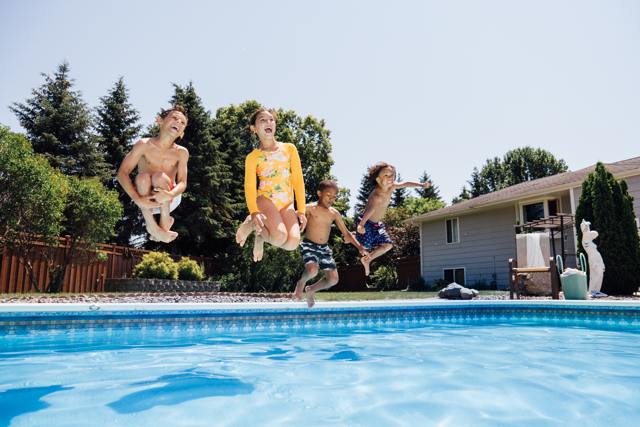This blog is the fourth part in our series breaking down the FOSS Swim Path®. Read the third part on Flip to Breathe.
The ability to swim confidently is the ultimate goal we have established for the Foss Swim School Learn to Swim progression, the first and largest part of the Foss Swim Path® . But what does ‘swim confidently’ mean, and what skills must students master to reach this milestone and officially graduate from our Learn to Swim program?
In terms of swimming, false confidence is worse than no confidence. A person who believes they can swim simply because they enjoy splashing around or made it from one end of the pool to the other run the risk of getting in over their head – in every sense of the term. We strive for the confidence that comes from mastery of skills and sufficient repetition to ensure a swimmer knows their abilities and can put their skills into practice.
Beyond safety, the ability to swim confidently opens up a world of healthful activity and fun. With the skills learned by graduates, they can engage in water sports, swim in the ocean, snorkel, waterski or wakeboard, do laps at the health club, or just feel comfortable diving in wherever there is an opportunity to express their love of water.
Swim Confidently = 300 feet of strong front crawl and backstroke
We are looking for both duration and quality of swimming ability in these last classes of the Learn to Swim progression. Swimmers of almost any age can reach this milestone. For our Middle students, these skills are taught in levels 3 and 4, Big students in levels 2 and 3, and for 10+ classes in levels 1 and 2.
Swimming Confidently means the ability to swim a solid freestyle (aka front crawl) and backstroke. At this point in the program, we start to talk about strokes by their real names, not the more playful names used in earlier levels, a purposeful shift for our maturing students.
The 300 foot distance is broken into 5 repetitions of 60 feet in the final evaluation, which might look different in different classes depending on how the lane is set up. This is a meaningful distance for young swimmers – in many cases, the ability to swim 300 feet is enough to reach the safety of a boat or shore in case of emergency. More importantly, it’s far enough that a swimmer needs to be swimming correctly to cover it. If you can swim 300 feet correctly, you have the foundation needed to swim further just practicing the skills you have.
How students learn to “Swim Confidently” at Foss Swim School
When students graduate from the Learn to Swim progression, they have put together all the skills they have learned up to this point. In the classes a student takes to reach the Swim Confidently milestone, most of the lessons are combinations of skills rather than focusing on individual motions. But the order and way we teach these skills matters:
- A solid side breath: The flipping skill learned earlier now turns into the foundation of the freestyle: the side breath. Students learn to rotate just halfway from a face-down position to breathe with their face to the side while kicking enough to remain on the surface. The timing and core strength needed takes practice, but is the key to an effective freestyle stroke.
- Backstroke with two arms – then one: In earlier levels, students learned to “paint the ceiling” with one arm while using a flotation aid with the other. At the start of the Swim Confidently classes, they now put it together, swimming the backstroke with both arms. But in the final stages of Swim Confidently, we go back to swimming with one arm and no flotation aid. Why? Because now we are building strength and confidence. A student who knows the timing of both arms but can swim the 300 feet with one arm at a time has the knowledge AND strength to swim the backstroke confidently.
- A complete freestyle: The freestyle is the most efficient, fastest stroke and the foundation of swimming well. Having mastered the side breath, students move on to putting the arm motion, kicks and side breath together, culminating in swimming the 300 foot requirement.
- Introduction to breaststroke and butterfly arms: Students don’t need to master the other two “competitive” strokes – the breaststroke and butterfly – to graduate from Learn to Swim, but we do require them to learn the arm motions. These skills work different muscles and lay the foundation for students who want to learn to Swim Stronger.
Reaching the Swim Confidently milestone, graduating, and what’s next
As noted, students who reach this milestone are graduates of our Learn to Swim progression. So what’s next? First, a lifetime of healthy fun and activity! We hope all of our graduates will spend many happy hours and years in the water. It’s also important to exercise a skill to keep it fresh and strong, so find a reason to get in the pool, lake or ocean whenever you can!
We also encourage students to continue their Swim Path® journey into our next progressions, Swim Stronger (which teaches the breaststroke and butterfly while building endurance and technique) and Swim Faster, (which teaches specific techniques for competitive swimming, including turns, and refines technique to maximize speed and power.)
We realize not every swimmer wants to swim competitively, and for some of our students completing Learn to Swim is as far as they will go on the Swim Path® . But we encourage you to consider moving on to Swim Stronger – here students gain an extra level of skill and confidence, plus more robust health benefits from the extra length and intensity of the class. But whatever you decide, we are proud of all our graduates, and are thrilled to have been a part of your student’s journey!
